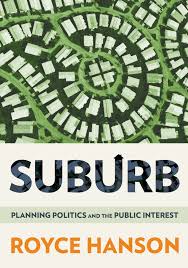Book review - Suburb: Planning Politics and the Public Interest
Authored by Royce Hanson and reviewed by Nicholas A Phelps
- Created
- 9 Jan 2019, 10:31 a.m.
- Author
- Nicholas A Phelps
- DOI
- 10.1177/0042098018813052
Suburb: Planning Politics and the Public Interest
Authored by Royce Hanson and reviewed by Nicholas A Phelps
Ithaca, NY: Cornell University Press, 2017; 324 pp.: 978-1-5017-0525-0, US$45.00 (hbk)
The great attraction of this book derives from the author’s intimate and extensive practical experience of planning as the two-time chair (1972–1981 and 2006–2010) of the uniquely powerful Maryland National Park and Planning Commission (M-NPPC). Importantly, instead of speaking of planning and politics the book makes use of the term ‘planning politics’ to emphasise the inseparable nature of the people involved and the logics they employ in the process of suburbanisation in Montgomery County, Maryland. The book is full of pithy one- or two-liners I imagine from this rich experience. Some of these, of course, hit the mark – ‘if all politics is local, all local politics is intensely personal’ (p. 11). Others – ‘Suburbs are places we hate to love’ (p. 1), ‘Sewers made suburban living possible. Automobiles made it feasible’ are, by now, more familiar and a little less searching. However, individually, and as a whole, they cause pause for thought in a way which few academic books do.
The book covers the history of suburban planning in Montgomery County, which Hanson takes as ‘typically unique’ of suburban counties across the USA. The book is organised to tell this history thematically instead of in a conventional chronological order – setting out a theoretical perspective on planning politics before proceeding on to nine chapters recounting grand, highly current and more topical themes covering: ‘on wedges and corridors’; ‘retrofitting suburbia’; ‘the death and life of Silver Spring’; ‘the end of suburbia’; ‘trials in Corridor city planning’; ‘errors in corridor city planning’; ‘the agricultural reserve’; ‘growth pains and policy’; and ‘the public interest’. Nevertheless, within each of these thematic chapters there is considerable chronological detail. Given the successes achieved in the county, several of these will have undoubted appeal to practitioners and academics given the present interest in the possibilities for a post-suburban future (Phelps, 2016) involving, among others, the retrofitting of suburbia, the repairing of sprawl, transit-oriented development, and new urbanist planning approaches.
Beyond the generalities of this specific treatment of the history of suburban development patterns and processes, the book, to my mind, also provides several highly interesting insights. For instance, perhaps bearing the marks of the author’s rich practice experience, the book on and off is strong in its reflections on planning practice and methods. While some of these reflections may appear a little outdated in terms of the current state of planning pedagogy, they undoubtedly reflect both the realities of planning practice and the lag between pedagogy and practice. Other reflections on the value of mobilising an historical perspective – both in order to gain a ‘prescriptive interpretation’ of the dynamics of suburban planning politics and as a source of techniques of use to planners – strike me as the sorts of issues worthy of greater consideration within planning theory.
For my specific interests, the book also provides strong vindication not only of the thought that growth machine politics in the USA, and perhaps elsewhere, has been suburban rather than urban or city-centred but that planning politics evolves as suburban communities themselves become more mature, complex, and urban (Phelps and Wood, 2011). Thus, as the book recounts, the early suburban development of Montgomery County took place initially under the aegis of growth machine politics but a politics concerned with leveraging uplifts in land values. Growth continued under political regimes that became less concerned with stewardship. Pressures for suburban development were briefly resisted under a progressive political regime before resuming more recently in arrangements that are characterised as a pure political regime in which there is little or no coherent or consistent vision.
The story told here is one of the immense efforts – to innovate in zoning and planning styles, over a lengthy period of 40 to 50 years, and across many separate locales – required to fashion a measure of urbanity from the traditional residential suburb. Moreover, the whole story is one that reaffirms the specifically geographical credentials of urban/spatial planning, in that ‘growth policy was invented to manage the rate of growth but had more impact on its location than on its amount, type, or timing’ (p. 242). Tellingly, Montgomery County achieved successes in smart growth planning despite failing to achieve many of the goals laid out in the 1964 M-NCPPC On Wedges and Corridors plan precisely because it was the only jurisdiction that really tried to achieve any of them. The Montgomery County story provides an important vindication of the value of planning as an imperfect act of persistence.
References
| Phelps, NA (2016) Sequel to Suburbia: Glimpses of America’s Post-Suburban Future. Cambridge, MA: MIT Press. Google Scholar |
|
| Phelps, NA, Wood, AM (2011) The new post-suburban politics? Urban Studies 48(12): 2591–2610. Google Scholar |
Related articles
If you enjoyed this review, the following articles published in Urban Studies might also be of interest:
|
Imaginations of post-suburbia: Suburban change and imaginative practices in Auckland, New Zealand by Cameron Johnson, Tom Baker and Francis L. Collins |
by Steven Henderson |
|
Mind the gaps! A research agenda for urban interstices by Nicholas A Phelps and Cristian Silva |
Tenure change in London’s suburbs: Spreading gentrification or suburban upscaling? by Antoine Paccoud and Alan Mace |



Comments
You need to be logged in to make a comment. Please Login or Register
There are no comments on this resource.